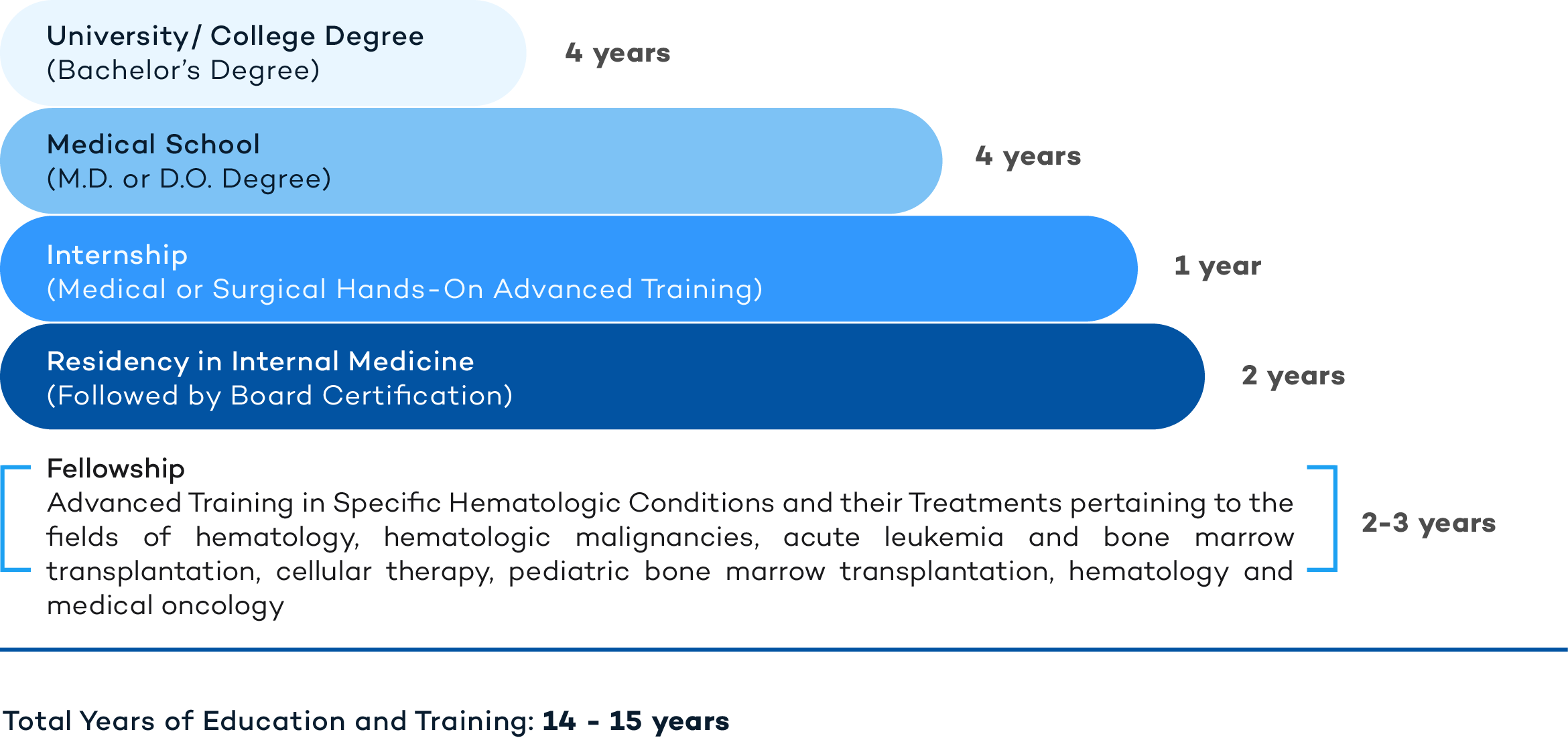

A Hematologist is a Board-Certified Doctor who provides preventive and medical care for blood-related and vascular system conditions. Hematologists care for people of all ages and are trained to handle a comprehensive range of blood, bone marrow, immune system, hemostatic system and vascular system concerns and all the related diseases.
If you have a condition that requires evaluation by a Hematologist, it is very important that you choose a physician that you feel comfortable with, and are able to easily communicate with. Your primary care physician, also referred to as PCP (Internal Medicine, Family Medicine, Pediatrics, or OB/GYN), can facilitate a referral to a hematologist, and you can also do your diligence and check the credentials and practice style of the doctor with the help of your family and friends. At myDoqter, you have access to patients’ feedback about doctors, and you can also see the professional recommendations given by other physicians who have witnessed first-hand the expertise and professional competency of your doctor.
Hematologists are physicians (M.D. or D.O.) with advanced medical degrees and training. The following is a representation of the years of education and training that a Hematologist has undergone.

HEMATO from the Greek root ‘Haima’ for ‘Blood’ + LOGY from the Greek word ‘logia’ which means ‘logic’ or ‘ the study of’.
Hematologists treat an extensive list of diseases related to blood, bone marrow, and the immunologic, hemostatic (blood clotting) and vascular system, including:
Leukemias: These are cancers of blood cell precursors that involve the malignant changes and abnormal cell formation and proliferation of these cells. Several types exist, including: Acute Lymphoblastic Leukemia (ALL), Acute Myeloid Leukemia (AML), Chronic Lymphocytic Leukemia (CLL) and Chronic Myeloid Leukemia (CML). Many patients with slow growing forms of leukemia do not have any symptoms. But in the rapidly growing forms of leukemia, patients experience symptoms such as weight loss, fatigue, frequent infections and easy bleeding or bruising. For the slow growing forms of leukemia, only monitoring may be necessary. For the faster growing leukemias, chemotherapy may be necessary, followed by radiation and/or stem cell transplant.
Acute Lymphocytic Leukemia: Also known as ALL, this is a cancer of the blood and bone marrow (soft inner part of the bone) that affects white blood cells. When abnormal white blood cells (leukemia cells) accumulate in the bone marrow affecting normal cell growth, they are carried through the bloodstream, rapidly spreading and affecting other organs. Associated symptoms include: enlarged lymph nodes, bruising, fever, bone pain, bleeding from the gums, and frequent infections.
Acute Myelogenous Leukemia: Also known as Acute Myeloid Leukemia or AML, this is a cancer of the blood and bone marrow (soft inner part of the bone) which starts in the bone marrow and is due to an excess of immature white blood cells. Patients often have associated symptoms, including fatigue, recurrent infections, and easy bruising.
Aplastic Anemia: This is an autoimmune disease in which the body fails to produce blood cells or there is an unexplained failure of the bone marrow to produce blood cells of any type. This is a rare condition. Associated symptoms of this condition include fatigue, frequent infections, rapid heart rate, shortness of breath, nosebleeds, bleeding gums, pale skin and unexplained bruising.
Hemophilia: Hemophilias are rare genetic diseases of the blood, where your blood does not have the ability to clot properly due to the lack of specific proteins that are necessary for clotting to take place. As a result, these diseases often present with easy bruising, bleeding in the mouth and nose, bleeding in the joints showing as pain and swelling around the joints, and blood in the urine or stools.
Anemia: Anemias come in many forms but have the general characteristic of decreasing the overall red blood cell mass. There are many different types of anemia, but the most common include: Iron Deficiency and Folate Deficiency Anemias. The red blood cells are the cells that normally carry oxygen to the tissues and muscles, so they can carry out their functions. Since the red cell mass is decreased in anemias, the symptoms often include: fatigue, lightheadedness, dizziness, palpitations and headaches.
Lymphoma: Lymphomas are cancers that involve the malignant transformation of lymph node cells. There are two forms of lymphoma: Hodgkin’s and Non-Hodgkin’s Lymphoma. Hodgkin’s Lymphoma generally has a better prognosis or outcome than Non-Hodgkin’s Lymphoma. The main symptoms of lymphoma include: enlarged lymph nodes, fatigue and weight loss.
Multiple Myeloma: Multiple Myeloma is a form of bone marrow cancer that results in decreased production of various antibodies, and therefore makes it very difficult for the body to fight off infection. Symptoms are not always present, but may include: loss of appetite, fever and bone pain.
Deep Vein Thrombosis (DVT): DVT is the formation of a blood clot in a deep vein within our body. As a result, the venous circulation in that area is blocked. DVTs are commonly seen in the lower extremities, but can form in other parts of the body as well. The area with a DVT appears swollen, red and is tender to the touch, and at times the clots or masses can be felt. These tissue masses (clots) can be dislodged from the affected veins where they formed and move to your lungs, where they can block the circulation to pulmonary (lung) tissues and cause a Pulmonary Embolism (PE). PE is associated with shortness of breath and, ultimately, respiratory failure or even death. The American Society of Hematology states that Deep Vein Thrombosis (DVT) is a serious and often underdiagnosed medical condition, the complications of which kill more people each year than breast cancer, motor vehicle accidents and HIV combined.
Sickle Cell Disease: Sickle cell disease is due to a genetic defect of the globin (protein) chains in hemoglobin, which is contained within red blood cells and carries oxygen to the tissues and organs. As a result of this alteration in the globin chains of hemoglobin, the red blood cells are not be able to transport oxygen adequately and develop an abnormal shape (sickle). Sickle cells stick together and cannot move easily through the blood vessels. Consequently, many tissues and organs suffer complications, such as:
Recently, a company called CRISPR Therapeutics has developed the CRISPR/Cas-9-based technology to perform gene editing and successfully correct the sickle-cell mutation, resulting in a normal hemoglobin protein. This technology provides hope in finding a cure for sickle cell disease, as well as other conditions such as Beta-Thalassemia, Diabetes, Alzheimer’s Disease, among many other diseases.
Idiopathic Thrombocytopenic Purpura (ITP): ITP is an autoimmune disorder that causes the destruction of the coagulation factors needed for platelets to stop the bleeding in blood vessels when these are injured (either as a result of trauma or during surgery). ITP is associated with increased bleeding, easy bruising, and nose and mouth bleeds.
Thalassemia: Thalassemias are rare genetic conditions that are caused by the under-production of essential elements of red blood cells and hemoglobin. Because red blood cells are formed in the bone marrow as well as the spleen, and the body is trying to compensate and make more red blood cells, organs like the spleen are ‘overworked’ and can undergo failure. Because the spleen is also so important in the immune system and in filtering out infection, patients will often also suffer increased susceptibility to bacterial infections. Other symptoms of anemia in general include: shortness of breath, fast or irregular hear rate, skin paleness, weakness and dizziness.
Sepsis: Sepsis is a condition where the body decompensates due to overwhelming bacterial infection that has spread to the blood. Sepsis is a serious condition that can rapidly progress to death and must be treated immediately with antibiotics and other life-saving medications depending on the cause of sepsis. Sepsis is not a disease in and of itself, but rather the result of an underlying infection that spreads from the site of onset, through the blood and into other tissues, where it causes changes in function and a decrease in blood pressure that can eventually become fatal.
Hematologists also treat organs that are circulated by blood cells, including the lymph nodes, spleen, thymus and lymphoid tissue.
Although blood cancers cannot be prevented, your primary care doctor (Internal Medicine, Family Medicine, Pediatrics, or OB/GYN) will conduct an annual health examination that could help detect signs of these cancers early on. Also, if you have any of the symptoms discussed above, please consult your PCP for proper evaluation and possible referral to a Hematologist or Oncologist.
With regards to DVTs, typically your primary healthcare doctor will be the physician making the first assessment of this condition, as well as implementing treatment, although in some instances the patient may be referred to the hematologist for further workup of the condition underlying the reason for the DVT in the first place. Important topics to discuss with your PCP or Hematologist in the prevention of DVTs include:
If diagnosed with a blood cell cancer, your Hematologist/Oncologist will offer you a range of treatment choices for your specific condition and will work with you to find the best personalized approach and treatment choice for your specific needs. Please make sure to discuss all these options and any preventive recommendations with your physician.
You can read more about Hematology in the following links:
https://www.hematology.org/education/patients/blood-disorders/deep-vein-thrombosis
https://www.stoptheclot.org/learn_more/prevention_of_thrombosis/
https://www.healio.com/hematology-oncology/news/online/%7Bad3ed5c5-0488-4f09-92aa-429c889c1943%7D/what-is-a-hematologist
https://www.cdc.gov/ncbddd/dvt/links.html